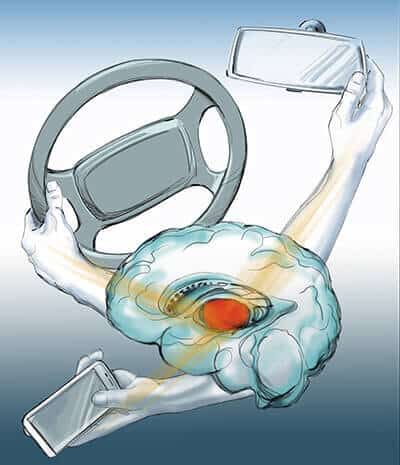In a study of mice, scientists discovered that a brain region called the thalamus may be critical for filtering out distractions. The study, published in Nature and partially funded by the National Institutes of Health, paves the way to understanding how defects in the thalamus might underlie symptoms seen in patients with autism, attention deficit hyperactivity disorder (ADHD), and schizophrenia.
“We are constantly bombarded by information from our surroundings,” said James Gnadt, Ph.D., program director at the NIH’s National Institute of Neurological Disorders and Stroke (NINDS). “This study shows how the circuits of the brain might decide which sensations to pay attention to.” Thirty years ago Dr. Francis Crick proposed that the thalamus “shines a light” on regions of the cortex, which readies them for the task at hand, leaving the rest of the brain’s circuits to idle in darkness.
“We typically use a very small percentage of incoming sensory stimuli to guide our behavior, but in many neurological disorders the brain is overloaded,” said Michael Halassa, M.D., Ph.D., the study’s senior author and an assistant professor at New York University’s Langone Medical Center. “It gets a lot of sensory input that is not well-controlled because this filtering function might be broken.”
Neuroscientists have long believed that an area at the very front of the brain called the prefrontal cortex (PFC) selects what information to focus on, but how this happens remains unknown. One common theory is that neurons in the PFC do this by sending signals to cells in the sensory cortices located on the outer part of the brain. However, Dr. Halassa’s team discovered that PFC neurons may instead tune the sensitivity of a mouse brain to sights and sounds by sending signals to inhibitory thalamic reticular nucleus (TRN) cells located deep inside the brain.
To study attention, Dr. Halassa’s team designed a test that challenged mice to focus and ignore distractions. The researchers trained mice to use either a light or a sound to figure out which of two doors hid a milk reward. Before each decision, the mice heard a noise that told them to anticipate the light or the sound that would lead them to the correct door. The mice then needed to use the right cue and ignore the irrelevant one in order to get their reward.
The researchers used genetically modified mice in which specific neurons could be activated or inhibited with rays of light. Silencing neurons in the PFC while the mice anticipated the cue increased errors. The mice chose the wrong door in response to the light or sound cue, implying they could not concentrate in that setting. In contrast, silencing neurons of the visual cortex, the part of the brain that processes visual information, during anticipation had no effect on attention. The mice chose the correct door in response to a light cue. Overall, the results suggested that connections between PFC and sensory cortical neurons were not involved with this type of attention, as previously thought.
Instead, further experiments suggested that the TRN played a critical role. Turning on TRN neurons involved in vision during anticipation of the light cue increased errors whereas turning that same circuit off had the opposite effect – the mice had trouble paying attention to the sound but not the light.
“We interpreted this to mean that inactivating the visual TRN makes irrelevant visual input much more distracting,” Dr. Halassa said.
The team also observed that when mice needed to focus on the light, activity dropped in the visual TRN and increased in the part of the thalamus that processes visual inputs, called the lateral geniculate nucleus (LGN). However, those changes did not happen when the PFC was inactivated. These findings suggested that the PFC modifies activity in the thalamus in order to shift attention toward visual information.
To figure out if fluctuations in the TRN and LGN were linked, the researchers developed a new technique called chloride photometry that allowed them to directly monitor how much chloride was entering LGN neurons in real time. The more chloride ions flowed into a neuron, the more inhibited the mice became. The group found that more chloride entered and inhibited the LGN during trials that required mice to ignore the light and focus on the sound.
“With this new technique, we can actually watch how circuit problems in the mouse thalamus may lead to problems with concentration that underlie certain neuropsychiatric disorders in humans,” Dr. Halassa said. This work may provide the mechanistic basis for Dr. Crick’s theory of the thalamic searchlight.
If our reporting has informed or inspired you, please consider making a donation. Every contribution, no matter the size, empowers us to continue delivering accurate, engaging, and trustworthy science and medical news. Independent journalism requires time, effort, and resources—your support ensures we can keep uncovering the stories that matter most to you.
Join us in making knowledge accessible and impactful. Thank you for standing with us!

